
IT
FABBRICANTE
PORTWEST LIMITED, IDA Business Park, Westport, Co. Mayo, Ireland
Any additional information please keep contact with the manufacturer
Nome e indirizzo dell’organismo certificato che ha rilasciato il certificato CE:
INSPEC INTERNATIONAL LTD, 56 LESLIE HOUGH WAY, SALFORD,
GREATER MANCHESTER, M6 6AJ ENGLAND NOTIFIED BODY NUMBER: 0194
NOTIFIED BODY RESPONSIBLE FOR THE ONGOING CONFORMITY UNDER
MODULE D: INSPEC INTERNATIONAL LTD NOTIFIED BODY NUMBER 0194
Il rumore forte nel posto di lavoro può essere molto dannoso per
l’udito e di solito il danno avviene gradualmente, in modo che
i lavoratori non sono consapevoli dei pericoli fino a quando non
hanno già sviluppato una perdita uditiva permanente. Oltre alla
perdita di udito graduale, c’è anche la perdita dell’udito che deriva
da rumori improvvisi ed estremamente forti. Questi dispositivi di
prozione auricolare aiutano a ridurre l’esposizione a rumori pericolosi
e ad altri suoni forti.
Questi tappi auricolari sono progettati per proteggere chi li
indossa da rumori nocivi. Queste protezioni auricolari devono essere
indossate sempre nei luoghi rumorosi (ambienti superiori a 80dB)
e devono essere scelti in funzione ai relativi indici di attenuazione,
in rapporto al rumore ambientale da ridurre (vedere le prestazioni).
Assicurarsi che siano correttamente adattati, regolati, conservati,
conformemente al presente foglieto illustrativo. In caso di mancato
rispetto delle presenti istruzioni, le prestazioni potrebbero essere
gravemente compromesse.
adeguare VD ILLUSTRAZIONI
Controllare che i tappi auricolari vengano inseriti, adattati ed
indossati seguendo le istruzioni di seguito. Tutte le manipolazioni
devono essere effettuate con le mani pulite : Girare il tappo auricolare
tra le dita fino ad ottenere un cilindro molto sottile. Liberare il
condotto uditivo tirando il lobo dell’orecchio ed introdurre il tappo
con un leggero movimento rotatorio. Aspettare qualche istante e
lasciare che il tappo riprenda la propria forma nel condotto uditivo.
In caso di rumori di sottofondo, verificare che i tappi per orecchie
attenuino bene il rumore, non lasciandolo passare, altrimenti
riposizionarli. Indossarli per tutta la durata dell’esposizione al
rumore. Per toglierli, seguire le stesse istruzioni osservate per
indossarli. Fare attenzione ad un’estrazione troppo rapida che
rischierebbe di danneggiare il timpano.
AVVERTIMENTI :
Se i tappi auricolari sono dotati di un elemento di raccordo se ne
sconsiglia l’utilizzo, se vi è il rischio che l’elemento di raccordo resti
impigliato su qualcosa durante l’utilizzo. Il contatto con la pelle
potrebbe provocare reazioni allergiche su soggetti particolarmente
sensibili; in tal caso, abbandonare la zona a rischio, rimuovere le
protezioni e consultare un medico. Alcune sostanze chimiche possono
avere un effetto negativo su prodotto. Per maggiori informazioni
rivolgersi al fabbricante. Tenere fuori dalla portata dei bambini, i
piccoli pezzi potrebbero essere facilmente ingeriti.
ISTRUZIONI PER LO STOCCAGGIO E LA MANUTENZIONE:
I tappi auricolari devono essere conservati in un ambiente fresco
e asciutto, lontano da gelo e luce e protetti da polvere, grasso
o prodotti chimici. Nelle normali condizioni d’uso, questi tappi
auricolari rimarranno efficaci per 1 anno dopo l’uso iniziale, per
quanto riguarda l’archetto, mentre i tappi auricolari dovrebbero
essere sostituiti dopo un turno di lavoro (8 ore) o prima se si
sporcano. Quando non sono in uso, i tappi auricolari devono essere
conservati nella loro confezione originale. La condizione dei tappi
auricolari dovrebbe essere controllata regolarmente. Trasportare il
protettore auricolare nel suo imballo originale.
La durata consigliata è di 3 anni dalla data di produzione indicata
sulla confezione, ad esempio mm / aaaa (mese / anno).
PRESTAZIONI - ATTENUAZIONE ACUSTICA (in DB):
(Vedi tabelle allegate)
SNR = Valore unico di attenuazione media
A = Frequenza (Hz); / B = Attenuazione media (d/ B); /
C = deviazione standard (d/ B); / D = Protezione presunta (d/ B).
Attenuazione in dB: H = frequenze alte / M = frequenze medie /
L = frequenze basse
LIMITAZIONE:
Il valore della Riduzione Semplicafata del Rumore (SNR) è basato
sull’attenuazione del rumore continuo e questi dispositivi di
protezione auricolare potrebbero non essere adatti nelle seguenti
situazioni:
-Utilizzo in ambiente con rumore intermittente o impulsivo, dove è
necessario un livello elevato di attenuazione del suono.
-Utilizzo in ambienti che richiedono un’attenuazione aggiuntiva,
specialmente nell’ambiente ad alta rumorosità dominato da
basse frequenze.
Scarica la dichiarazione di conformità
@ www.portwest.com/declarations
ANTIRUMORE: TAPPI
EP20 EP022; EP21 EP022;EP06
FOGLIETTO ILLUSTRATIVO
FOGLIETTO ILLUSTRATIVO
TUTTI QUESTI PRODOTTI SONO CONFORMI AI REQUISITI DEL REGOLAMENTO UE 2016/42 E I REQUISITI GENERALI DELLA
NORMA EN 3522: 2002
EP20 (EP02-2) : Tappi auricolari monouso in poliuretano ø6 - ø12 mm
EP21 (EP02-2) : Tappi auricolari monouso in poliuretano ø6 - ø12 mm
EP06: Tappi auricolari monouso in poliuretano ø7 - ø11 mm
Vedere informazioni fornite dal Fabbricante
PRESTAZIONI ATTENUAZIONE ACUSTICA EN3522:2002
ANSI S.19-1974
EP20 (EP02-2) / EP21 (EP02-2)
A Frequency (Hz) 125 250 500 1000 2000 4000 8000
B Means Attenuation (dB) 33.0 33.3 36.1 37.1 36.1 41.8 38.5
C Standard Deviation (dB)
6.7 7.6 7.4 4.7 4.8 3.6 3.9
D Assumed Protection (dB)
26.3
25.7 28.7 32.4 31.3 38.2 34.6
SNR = 34 dB H = 33 dB / M = 31 dB / L = 28 dB
EP20 (EP02-2) / EP21 (EP02-2)
A
Frequency (Hz) 125 250 500 1000 2000 3150 4000 6300 8000
B
Mean Attenuation (dB)
37.3 40.8 43.1 41.6 40.7 45.6 46.2 49.4 48.3
C
Standard Deviation (dB)
5.9 5.3 5.0 4.8 2.8 4.2 4.2 4.4 4.5
Tested by Michael & Associates, Inc.
EP06
A Frequency (Hz) 125 250 500 1000 2000 4000 8000
B Means Attenuation (dB) 31.6 34.3 35.8 35.0 35.4 45.3 44.7
C Standard Deviation (dB)
4.9 5.1 5.0 4.8 4.0 4.2 4.5
D Assumed Protection (dB)
26.7
29.2 30.8 30.2 31.4 41.1 40.2
SNR = 34 dB H = 33 dB / M = 31 dB / L = 30 dB
Note : EP06 model of ear plugs has satisfied the optional requiremnts at +20
0
C
i
EN 352-2 : 2002
0194
135USP

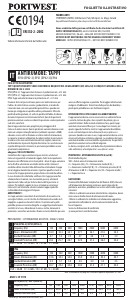



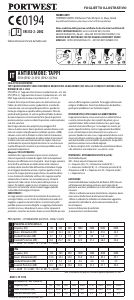
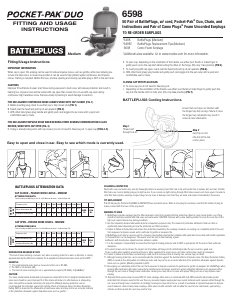
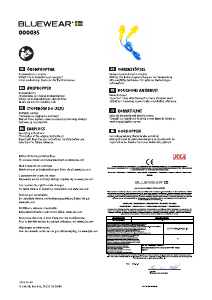
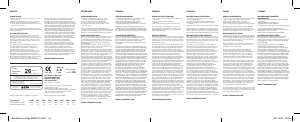
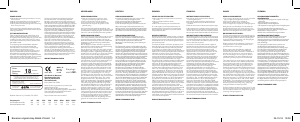
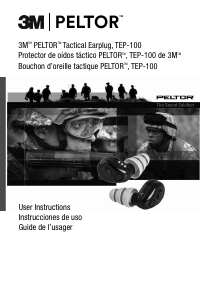
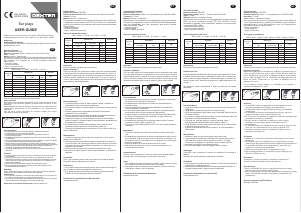
Join the conversation about this product
Here you can share what you think about the Portwest EP20 Ear Plugs. If you have a question, first carefully read the manual. Requesting a manual can be done by using our contact form.